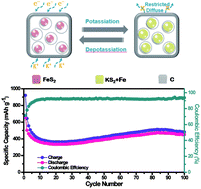Nanocubes composed of FeS2@C nanoparticles as advanced anode materials for K-ion storage†
Abstract
K-ion batteries (KIBs) are considered as one of the most promising devices for large-scale energy storage because of the comparable output voltage with lithium-ion batteries and the abundant reserves of potassium. FeS2 is regarded as a kind of very important anode material for KIBs due to its low cost and high capacity. However, the poor electronic conductivity and huge volume expansion of FeS2 during the discharge/charge process strongly inhibit the K-storage performance. To solve these problems, herein, unique core–shell FeS2@C nanocubes with nanoparticles in the interior and carbon shells in the exterior are designed. The inside FeS2 nanoparticles are beneficial for K+ diffusion and the penetration of the electrolyte, while the outside carbon shells can enhance the electronic conductivity and suppress the volume expansion. The unique core–shell structure displays outstanding K-storage performance with impressive specific capacity, excellent cycling stability, and superior rate capability with 73% capacity retention at 2 A g−1. This work not only provides solutions to obtain a superior anode material for KIBs but also offers insights into designing a hierarchical structure for energy storage systems.



 Please wait while we load your content...
Please wait while we load your content...